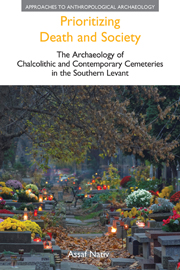 Prioritizing Death and Society
Prioritizing Death and Society from Part II - Chalcolithic cemeteries
Cemeteries consisting of a single cave are encountered primarily between the Alexander and Qishon streams, where at least nine cemeteries of this sort have been reported to date (see Table 4.1). They appear in a variety of settings: along the coast, along the eastern border of the Menashe Hills, along the Samarian piedmont and along the region's main watershed. Depending upon their geological settings they were either wholly artificial, hewn into kurkar (solidified sand) or chalk, or utilized natural cavities in limestone and dolomite. Often paved areas and benches were built, intended to serve as platforms for the deposition of human remains and ossuaries.
The quality of the data available for each cemetery varies considerably from one case to the next, depending upon preservation, excavation techniques, analysis and publication. Ma'abarot and Horbat Castra, which will be presented in this chapter, are the only sites for which relatively comprehensive information is available, encompassing anthropological data, assemblage composition and contextual details. All other sites either offer observations into one (or rarely two) of these aspects or settle for a general description (see Table 4.1).
Discussion will begin with general observations concerning the distribution of the sites. Next, the case studies of Horbat Castra and Ma'abarot will be presented. Based upon these, we will then proceed to consider more general patterns as they are augmented by comparatively fragmentary information provided for other sites.
To save this book to your Kindle, first ensure [email protected] is added to your Approved Personal Document E-mail List under your Personal Document Settings on the Manage Your Content and Devices page of your Amazon account. Then enter the ‘name’ part of your Kindle email address below. Find out more about saving to your Kindle.
Note you can select to save to either the @free.kindle.com or @kindle.com variations. ‘@free.kindle.com’ emails are free but can only be saved to your device when it is connected to wi-fi. ‘@kindle.com’ emails can be delivered even when you are not connected to wi-fi, but note that service fees apply.
Find out more about the Kindle Personal Document Service.
To save content items to your account, please confirm that you agree to abide by our usage policies. If this is the first time you use this feature, you will be asked to authorise Cambridge Core to connect with your account. Find out more about saving content to Dropbox.
To save content items to your account, please confirm that you agree to abide by our usage policies. If this is the first time you use this feature, you will be asked to authorise Cambridge Core to connect with your account. Find out more about saving content to Google Drive.